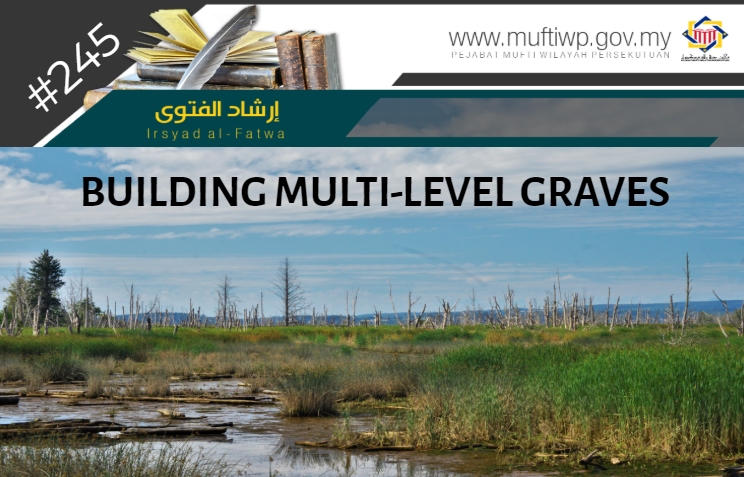
Question:
What is the ruling for building multi-level graves?
Answer:
Alhamdulillah, praise and thanks to Allah for the countless blessings He has blessed us all with. Blessings and salutations to the Prophet Muhammad PBUH, his wives, his family, companions and all those that follow his teachings to the day of judgement.
Allah SWT states in the Quran:
ثُمَّ أَمَاتَهُ فَأَقْبَرَهُ
“Then He causes his death and provides a grave for him.”
Surah ‘Abasa (21)
Al Imam al-Qurtubi in commenting on this verse said: Allah SWT made graves for humans to cover his corpse as a sign of honor for him, if the corpse is left alone, it will be disgusting, and animals would eat it. This verse also means that Allah SWT is commanding us to bury the dead and to not burn the corpses after someone had die. (See: AI-Jami' Li Ahkam al-Quran, 19/219)
From this verse, it is understood that burying humans’ corpses is a sunnah from Allah SWT to his servants, thus, humans’ corpses cannot be thrown anywhere like animals or be burnt as what is happening in our society today. This is the honor for humans from Allah SWT.
Regarding the issue of multi-level graves, we would start the discussion as follows:
- The form of multi-level graves
The second fatwa issued by Mufti State Department of Selangor, gazetted on 7th October 2004 states:
“Burial grounds that are full and if there are no other open spaces to widen the burial ground, then, it is advisable to reuse the land using this method: Piling up 4 feet of soil onto the ground, on the old grave. This method is suitable for burial grounds situated in lowlands.”
We find that in some places, the corpse is pushed into the ground. However, we agree with the fatwa issued by the Selangor state.
- Countries that build multi-level graves
Among the countries that adopt multi-level graves are; Egypt, Singapore and maybe a few other countries.
- Fatwa by Scholars
There are a few fatwa bodies and Islamic scholars that presented their opinions:
First: Lajnah Fatwa Egypt’s Dar al-Ifta’ said: In Islam, it is obligatory to bury every corpse in its own grave, may it be its own lahad or syaq, and it must not be combined with other corpses, except when in desperate situations where there is no enough space of the burial ground. There is a hadith that state the Prophet PBUH gathered two or three martyrs in the war of Uhud and bury them together, and it is obligatory to separate the graves of a man and a woman. Thus, when it is necessary to bury more than one corpse in one grave, for there is no other space, then it is permitted to build multi-level graves to accommodate the increasing number of death.
Second: Syeikh Prof Dr Hamid Abu Talib, Dean of Kuliyyah of Islamic Law, Al-Azhar University, when answering about this issue, he said: In desperate situations, for example, the population density is too high and there is no enough space, then it is permitted to build multi-level graves.
- Muzakarah of Fatwa Committee of the National Council
The Muzakarah of the Fatwa Committee of the National Council for Islamic Religious Affairs of Malaysia, the 92nd meeting convened on 15th -17th December 2010 discussed this issue and decided as follows:
After listening to the briefings, views and arguments submitted by the Town and Country Planning Department, muzakarah is of the view that it is permitted and not contrary to syarak, but on condition that it is in desperate situations like the following:
- Population density is too high.
- Restricted cemetery land.
In this regard, muzakarah agrees and decides that based on the principles of Islamic law, the construction of multi-level burial grave is permitted, if the need is urgent to overcome the shortage of Muslim cemetery today.
However, the study of its implementation modules needs to be thoroughly scrutinized by taking samples from other countries that have implemented them as well as taking into account cost savings and the like.
Our Opinion
After looking at the situation in Malaysia, we divide it into two situations:
First: In villages and provincial areas. Since there are vast state of land and many waqf land for graveyards, then the need to build multi-level grave is unnecessary. We believe that although grave lands are so extensive, it is desirable that grave management begins to implement an arrangement system for graves, so that the land can be used to its maximum capacity since the demand for burial grounds has increased tremendously these days. Similarly, the need to manage cemetery the best we can is necessary in order to maximize the number of dead persons to be buried at the cemetery.
The cleaning of the grave and the neat arrangement is very important in order to facilitate family members or friends to visit, so that the living could comfortably come and visit the deceased and taking lessons while, reflecting on death.
Second: In major cities like Kuala Lumpur, where due to rapid development, burial grounds are limited while the number of deaths from time to time increased which required more and more grave lands. This can be observed in many cemeteries around Kuala Lumpur.
Therefore, we believe that the law of building a multi-level grave is necessary and permissible. We would also like to state that the Federal Territory Religious Department (JAWI) and the Federal Territory Islamic Religious Council (MAIWP) should collaborate to implement multi-level cemeteries to maximize the use of burial grounds so that there will not be an issue of not enough space for burial of any Muslim. The burial of the body of a deceased is a collective obligation (fard kifayah) according to the Islamic law.
Hopefully, the issue of insufficient land for Muslim cemetery in major cities can be solved by the construction of a multi-level grave.

